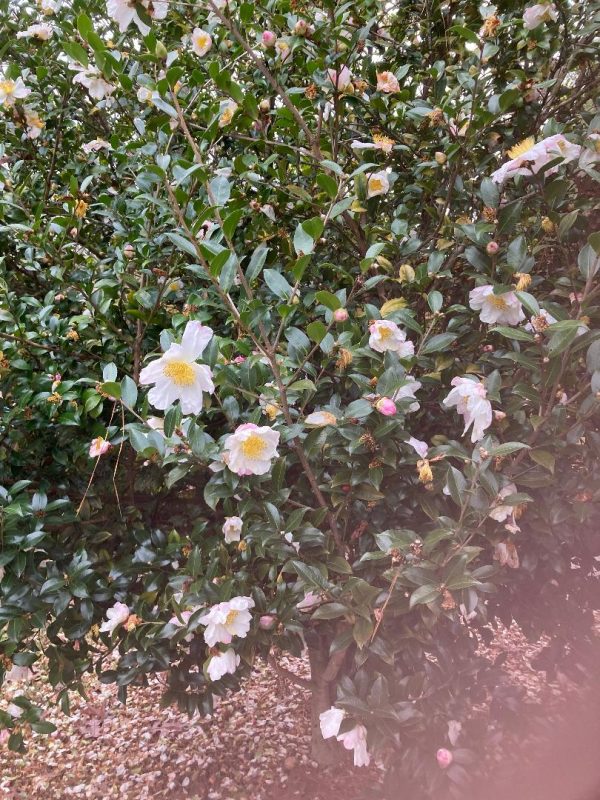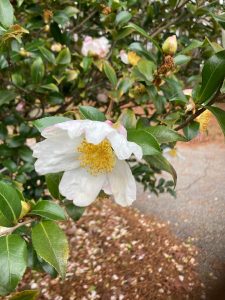Rose – Carefree Varieties

My favorite breakfast cereal has been “improved” once again. Now I’m implored to “Try It Hot!”.
Never mind that my mother tried oatmeal hot fifty years ago and found that it tasted about as good cold as it did warm. Boiling the water to make the cereal hot, though, warmed our chilly kitchen — so that’s what we children got every day before school: warm oatmeal.
Would that oatmeal could keep roses as healthy as it kept the Reeves kids! I recently ran across an interesting report from the horticulturists at Texas A&M University. There they have an endowed professorship devoted entirely to rose breeding, emphasizing disease-resistance.
According to the report, the rose team has tested more than one hundred roses for the past five years. They were grown under the harshest conditions: poorly aerated, highly alkaline clay soil, with no amendments. Furthermore, the roses received no fertilizer, pruning, deadheading or pesticide sprays. The only care they got was drip irrigation and a three inch layer of wood chip mulch. Those that did well were further tested at sites scattered across the state.
The results? At the end of five years, ninety six of the cultivars “looked terrible”, eleven appeared “promising”, and ten were “magnificent”. The top ten performers were ground-cover rose ‘Sea Foam’; dwarf shrub ‘Marie Daly’; small shrubs ‘Caldwell Pink, ‘Knock Out’ and ‘Perle d’Or’; medium shrubs ‘Belinda’s Dream’, ‘Else Poulsen’, ‘Katy Road Pink’ and ‘Mutabilis Butterfly’; and climber ‘Climbing Pinkie’.
Most of these roses bloomed all season (seven months in northern Texas) despite high humidity and heat up to 108 degrees F., and in acid and alkaline soils. Pest damage was negligible.
If you are contemplating planting a rose this spring, why not start out with a variety that will give you little trouble? The researchers noted that most modern roses looked good the first year but failed by the third year. Many of the antique cultivars were mediocre at first but spectacular in the third and following years. I planted a ‘Knock Out’ rose two years ago and it has bloomed wonderfully for two seasons with no perceptible leaf damage. Dr. Jean Williams-Woodward, Extension plant disease specialist, says she has seen some powdery mildew on ‘Knock Out’ but not much else.
RULES FOR ROSE SUCCESS Rose experts in Atlanta attempt to grow all sorts of rose varieties. However, they all know that to have a chance of success there are three basic rules: a minimum of eight hours of sun a day, good air circulation, and no sprinkler irrigation after late afternoon. They also amend the soil liberally with compost or soil conditioner, apply an organic mulch, and feed roses three times: in early and late spring, then lightly in midsummer.
FOR ROSE ZEALOTS Rose growers can be divided into three classes: lackadaisical, committed and fanatic. Those in the first class dig a small planting hole, shove the rose in place and hope it survives. Committed rose growers follow the rose rules above. Fanatic rose growers develop their very own special rose soil and use it whenever they plant.
Pat Henry, the owner of Roses Unlimited, digs a hole eighteen inches deep and wide. She fills the hole halfway with the following soil mixture, then packs more around her rose roots as she plants it. Pat swears by the results!
Pat Henry’s Special Rose Soil
In a wheelbarrow, mix enough of the following ingredients, in the proportions indicated, to fill the hole:
one fourth part compost
one fourth part peat moss
one fourth part good topsoil
one fourth part red clay
Add and mix thoroughly:
1 cup 0-46-0 (superphosphate)
1 cup dolomitic lime
2 cups alfalfa meal (or alfalfa pellets)
1 cup gypsum
Despite my mother’s praise for warm oatmeal, I am disregarding my brand’s exhortation to “Try It Hot!”. I’ll stick with cereal and cold milk plus proven, disease-resistant roses to keep myself and my garden healthy.
See Georgia Roses













